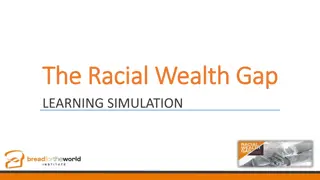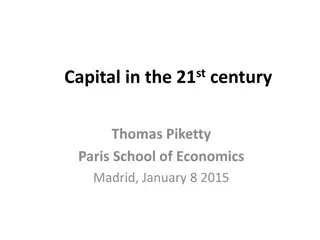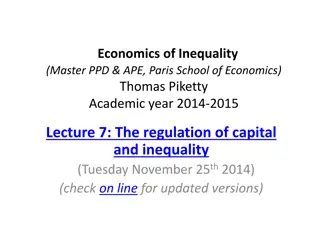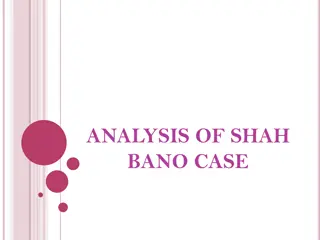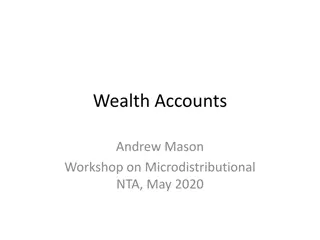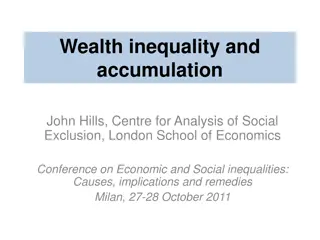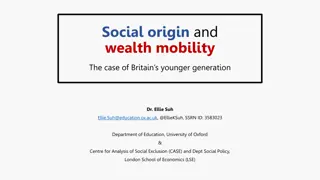Comprehensive Guide on Wealth Management Strategies by Rajesh Shah
Learn about wealth management essentials like asset classes, income sources, investment goals, risk management strategies, cash flow management, asset allocation, real estate investments, and more. Explore various types of assets, income sources, expenditure categories, investment goals, risk sources, and ways to manage risk effectively. Discover the importance of diversification, insurance, and hedging in managing risks. Master the art of analyzing risks, cash flow management, and asset allocation strategies to ensure financial growth and security. Dive into the world of wealth management with this in-depth guide.
Download Presentation

Please find below an Image/Link to download the presentation.
The content on the website is provided AS IS for your information and personal use only. It may not be sold, licensed, or shared on other websites without obtaining consent from the author. Download presentation by click this link. If you encounter any issues during the download, it is possible that the publisher has removed the file from their server.
E N D
Presentation Transcript
WEALTH MANAGEMENT By Rajesh Shah
CLASSES OF ASSETS Real estate Commodities (like gold silver bullion etc.) Debt Equity Liquid Other Assets 1. 2. 3. 4. 5. 6.
SOURCES OF INCOME/ TYPES OF EXPENDITURE Sources of Income Salary Business & Professional income Rental income Investment income Type of expenditure House hold expenses Life style expenses Insurance premiums Loan EMIs Others
WHY PEOPLE INVEST Interest Dividend Capital Appreciation Satisfy the long term & short term goals Mitigate Risk
GOALS Major Goals 1. Own Marriage 2. Buying A house 3. Children education 4. Children marriage 5. Independent retirement Minor Goals 1. Car Purchase 2. International Vacation 3. Holiday Home 4. Home Renovation 5. Family Gifting Other Financial goals 1. Reducing Tax outgo and Tax planning 2. Protection of Asset & Life 3. Debt Free 4. Charity
INVESTMENTS STRATEGIES Analyzing the risk Cash flow Asset allocation Monitoring Review
RISK Sources & Type of Risk Interest Rate Risk Reinvestment Risk Default Risk Liquidity risk Exchange rate risk Regulatory risk Investment manager risk Business risk Event risk
HOW TO MANAGE THE RISK Insurance Diversification Hedging
CASH FLOW Daily/Weekly/monthly & yearly budget Present value & Future value of money Annuities Net present value
ASSET ALLOCATION Returns Capital protection Inflation Taxation Liquidity Divisibility
REAL ESTATE Residential property Commercial property Industrial property Agricultural/urban land Holiday resort New instrument REIT
GOLD & BULLION Coins/Bars/Raw Gold/Silver Jewellery Gold & Gold ETF Gold Bonds
FINANCIAL ASSETS Small Saving Instruments Public provident fund National saving certificates Post office monthly income scheme Senior citizen saving scheme Post service saving scheme Post office recurring deposit Kishan Vikas Patra Marketable & fixed saving instruments Corporate bonds Fixed deposits Central & State Govt. treasury bills Debt mutual funds Money market/Liquid funds Debt / Income fund Diversified debt fund Gilt fund Short term debt fund High yield debt fund Fixed term plans
FINANCIAL ASSETS Equities Direct Equity Primary & Secondary market Private equity Venture/Seed & Angel capital Equity mutual funds Growth Fund Value Funds Dividend Yield Funds Large Cap/Mid Cap/Small Cap Funds Specialty/Sector Funds Diversified Funds Index Funds Balance/Hybrid Funds
OTHER ASSET Arts Coins Antiques Stamps Reverse Mortgage
WEALTH MANAGEMENT BY MUTUAL FUND Lump sum Systematic investment plan (SIP) Advantage of SIP Small ticket size Rupee Averaging Cover inflation & Interest Compounding Effect Tax Free/Efficient
REVIEW & MONITORING Quarterly analysis Ratio analysis Goal linked asset allocation Shift of investments Expert Advise
GOLDEN HEN Once, a farmer lived in a village. He was very poor. His income was very small. He passed his days with difficulty. One day, someone gave him a hen. It gave a golden egg every day. He sold the egg every day. Soon he became a rich man. All began to respect him in the village. He became greedy. He thought that inside the hen there must be a storehouse of golden eggs. He should get them in a day. Then he would be the richest man in the village. He took a knife and cut the stomach of the hen. He did not get even a single egg. He lost not only the golden eggs but the hen also. Moral: Greed is a curse.










